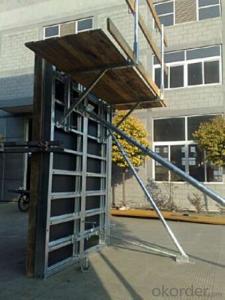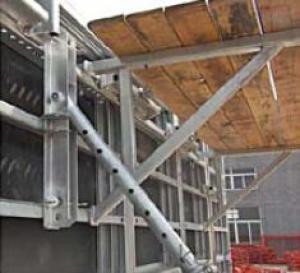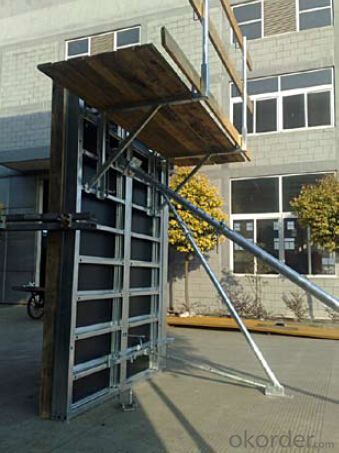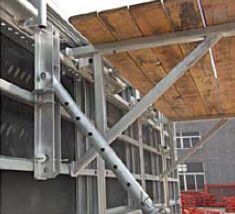Steel Frame Working Platformfor Formwork and Scaffolding system
- Loading Port:
- Tianjin
- Payment Terms:
- TT OR LC
- Min Order Qty:
- 50 m²
- Supply Capability:
- 1000 m²/month
OKorder Service Pledge
OKorder Financial Service
You Might Also Like
Steel-frame Formwork SF-140
Characteristics:
◆ Few parts for fast forming.
◆ Max. Concrete pressure: 80KN/m2.
◆ Hot-dip galvanized steel frame.
◆ The thickness of plywood is 18mm & the panel is 14cm.
◆ Compatibility with Hunnebeck Manto system due to similar edge profile.
System Details & Application:
◆ Neat joint and fast assembling with aligning panel clamp.
◆ Flexible panel arrangement and height extension.
◆ The selection of panels.
◆ Kinds of panel connectors.
◆ Corner clamp application.
◆ Length adjustment application.
◆ Height adjustment & aligning strut.
◆ Walkway bracket & platform.
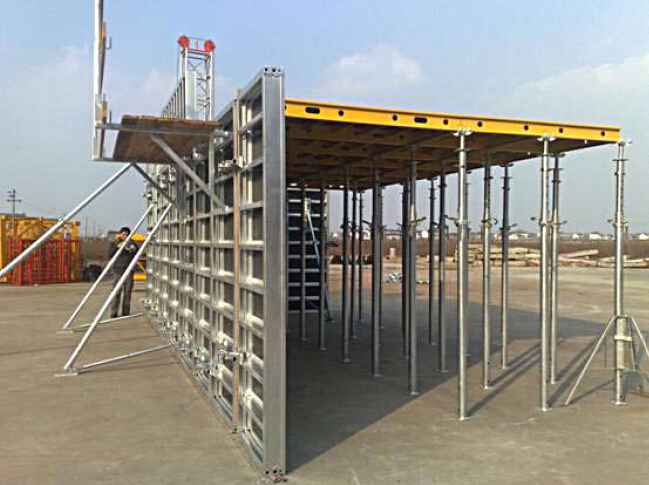
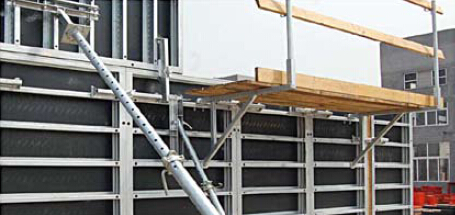
- Q: What are the standard sizes of steel formwork panels?
- The standard sizes of steel formwork panels can vary depending on the specific requirements of the construction project and the manufacturer. However, there are some commonly used standard sizes in the industry. Typically, steel formwork panels come in rectangular shapes with dimensions ranging from 1.2 meters to 2.4 meters in width and 1.8 meters to 3.6 meters in height. These standard sizes are designed to accommodate various construction needs and provide flexibility in forming structures such as walls, columns, slabs, and beams. The thickness of steel formwork panels can also vary, usually ranging from 12mm to 20mm. Thicker panels may be used for heavy-duty applications or to provide additional strength and durability to withstand the pressure exerted by concrete during pouring. It is worth noting that while these are common standard sizes, custom sizes can also be manufactured to meet specific project requirements. Additionally, some manufacturers may offer modular formwork systems that allow for easy assembly and disassembly by combining standard-sized panels in different configurations. Ultimately, the choice of steel formwork panel size depends on factors such as the size and complexity of the structure being formed, the load-bearing capacity required, and the ease of transportation and handling on the construction site.
- Q: Can steel formwork be used for curved or irregular shapes?
- Curved or irregular shapes can be achieved using steel formwork. Steel, a highly flexible material, can be easily manipulated into various sizes and shapes. Its strength and durability make it suitable for handling the pressure exerted by concrete during pouring and curing. To create curved or irregular shapes, steel formwork typically consists of modular panels that can be adjusted or bent to the desired shape. These panels can be easily connected together to form a continuous surface. Furthermore, steel formwork can be customized and welded to create intricate shapes that perfectly match the architectural design requirements. Steel formwork's versatility allows it to be used in a wide range of projects, such as buildings, bridges, tunnels, and dams. It provides a high-quality finish and can be reused multiple times, making it a cost-effective solution for projects that require repetitive shapes or structures with unique geometries. In summary, steel formwork is an excellent option for achieving curved or irregular shapes. Its flexibility, strength, and durability make it a reliable choice for construction projects that require complex and customized formwork solutions.
- Q: How does steel formwork handle different concrete surface texture requirements?
- Steel formwork is a versatile and durable option for handling different concrete surface texture requirements. It is designed to be adjustable and customizable, allowing for various surface finishes to be achieved. One way steel formwork handles different concrete surface texture requirements is through its ability to be easily modified and adapted. Steel formwork panels can be adjusted to accommodate different surface finishes such as smooth, textured, or patterned concrete. This flexibility makes it suitable for a wide range of construction projects, from simple slabs to complex structures. Furthermore, steel formwork provides a smooth and consistent surface, which is crucial for achieving a desired concrete finish. The rigid and sturdy nature of steel ensures that the formwork remains in place during the pouring and curing process, preventing any distortions or imperfections from occurring. This results in a uniform surface texture, regardless of the complexity of the design. Additionally, steel formwork offers excellent resistance to wear and tear, making it suitable for projects that require repetitive use or high-volume concrete pouring. The durability of steel formwork allows it to maintain its shape and integrity even after multiple uses, ensuring consistent concrete surface texture requirements are met over time. In conclusion, steel formwork is a reliable and adaptable solution for handling different concrete surface texture requirements. Its adjustability, durability, and ability to provide a smooth and consistent surface make it an ideal choice for achieving various finishes, regardless of the complexity of the project.
- Q: Are there any specific considerations for using steel formwork in areas with high seismic activity?
- Yes, there are several specific considerations for using steel formwork in areas with high seismic activity. Firstly, the steel formwork needs to be designed and constructed to withstand the seismic forces that occur during an earthquake. This includes ensuring that the formwork is adequately braced and anchored to prevent collapse or movement. Additionally, the connections between the different formwork elements should be strong and flexible enough to accommodate the seismic movements without compromising the overall stability of the structure. Furthermore, the selection of materials for the steel formwork should be appropriate for the seismic conditions, considering factors like strength, ductility, and corrosion resistance. Overall, proper design, construction, and material selection are crucial when using steel formwork in areas with high seismic activity to ensure the safety and integrity of the structure.
- Q: Is steel formwork suitable for projects with limited access?
- Yes, steel formwork can be suitable for projects with limited access. Steel formwork is known for its high strength and durability, allowing it to withstand the challenges of a project with limited access. It can be easily transported and assembled in confined spaces, making it a favorable choice for projects where access is restricted. Additionally, steel formwork can be easily dismantled and reused, which is beneficial in limited access situations where materials need to be transported in and out efficiently. The flexibility and adaptability of steel formwork make it a viable option for projects with restricted access.
- Q: How does steel formwork affect the overall sustainability of a concrete structure?
- The overall sustainability of a concrete structure can be significantly influenced by steel formwork. To begin with, the reusability of steel formwork allows for its utilization in multiple construction projects, thereby reducing the need for additional materials and minimizing waste. This reusability also aids in decreasing the environmental impact associated with the production and disposal of formwork materials. Furthermore, the durability and robustness of steel formwork ensure that it can endure repeated use without compromising its structural integrity. This durability extends the lifespan of the formwork, resulting in fewer replacements and less waste generation. Additionally, steel formwork provides superior strength and stability, enabling the construction of concrete structures with greater precision and efficiency. This allows for the use of less concrete, thereby reducing the overall carbon footprint of the structure. Moreover, the utilization of steel formwork can lead to quicker construction times, which in turn reduces energy consumption and minimizes the project's environmental impact. Moreover, steel formwork allows for greater flexibility in design and construction techniques, thus enabling the development of more sustainable structures. It can be easily customized to fit various shapes and sizes, optimizing space usage and reducing material wastage. This flexibility also allows for the incorporation of sustainable features such as energy-efficient insulation, green roofs, or rainwater harvesting systems. In conclusion, steel formwork positively influences the overall sustainability of a concrete structure through its reusability, durability, strength, and flexibility. By reducing waste generation, minimizing the use of concrete, and enabling sustainable design options, steel formwork contributes to the creation of more environmentally-friendly and efficient structures.
- Q: What are the different types of lifting systems used in steel formwork?
- There are several types of lifting systems used in steel formwork, each designed to meet specific requirements and provide efficient and safe lifting operations. Some of the common types include: 1. Crane lifting system: This is the most common and widely used lifting system in steel formwork. Cranes with various capacities are used to lift and position the steel formwork panels and components. They offer flexibility, high lifting capacity, and are suitable for large-scale construction projects. 2. Mechanical lifting system: This system utilizes mechanical devices such as winches, hoists, or jacks to lift and position the steel formwork. It is suitable for smaller projects or areas where cranes cannot access. Mechanical lifting systems are portable, easy to operate, and can be used in confined spaces. 3. Hydraulic lifting system: Hydraulic systems use fluid pressure to lift and move the steel formwork. They offer precise control and can handle heavy loads with ease. Hydraulic lifting systems are commonly used in high-rise buildings and projects where smooth and controlled lifting is required. 4. Manual lifting system: In some cases, manual lifting systems are used, especially for smaller formwork components or when there is limited access for machinery. This method involves manual labor to lift and position the steel formwork. It is cost-effective but requires more manpower and may not be suitable for larger or heavier formwork elements. 5. Pneumatic lifting system: Pneumatic lifting systems use compressed air to lift and move the steel formwork. They offer quick and efficient lifting operations and are suitable for projects with specific requirements, such as those involving hazardous materials or explosive environments. The choice of lifting system depends on various factors, including the size and weight of the formwork, project requirements, available resources, and site conditions. It is important to consider safety measures and ensure proper training and supervision when using lifting systems to prevent accidents and ensure smooth construction operations.
- Q: How does steel formwork contribute to the accuracy of concrete placements?
- Steel formwork contributes to the accuracy of concrete placements in several ways. First and foremost, steel formwork is known for its high level of dimensional accuracy. This means that the steel panels and components used in the formwork system are manufactured with precise measurements and tolerances, ensuring that the concrete structures being formed will have the correct dimensions and shape. Additionally, steel formwork provides excellent stability and rigidity, which prevents any movement or deformation during the concrete pouring and curing process. This stability is crucial in maintaining the accuracy of the concrete placement, as any shifting or warping of the formwork can lead to inconsistencies in the final product. Moreover, steel formwork is highly durable and can withstand the pressure exerted by the fresh concrete. This durability ensures that the formwork remains intact and maintains its shape throughout the entire placement process. It also eliminates the risk of bulging or sagging, which can compromise the accuracy of the concrete placement. Furthermore, steel formwork allows for precise control of the concrete's surface finish. With steel formwork, the concrete can be easily molded and shaped to achieve the desired surface texture and quality. This is particularly important in architectural applications where aesthetics play a significant role. Lastly, steel formwork is reusable and can be easily assembled and disassembled, allowing for multiple uses. This reusability factor contributes to cost-effectiveness and also ensures that the formwork remains in optimal condition for accurate concrete placements over time. Overall, steel formwork's dimensional accuracy, stability, durability, surface finish control, and reusability make it a valuable tool in achieving accurate and high-quality concrete placements.
- Q: Can steel formwork be used for precast concrete elements?
- Indeed, precast concrete elements can be constructed using steel formwork. The utilization of steel formwork in precast concrete fabrication is widely favored due to its robustness and ability to be reused. It creates a sturdy and inflexible framework capable of withstanding the force exerted by liquid concrete during casting and the load of solidified concrete after curing. Moreover, steel formwork guarantees a uniform and polished appearance for the precast elements, ensuring impeccable and accurate outcomes. Furthermore, the assembly and disassembly of steel formwork is effortless, enabling efficient manufacturing and convenient transportation of precast elements.
- Q: Are there any specific considerations for using steel formwork in areas with limited power supply?
- Yes, there are several specific considerations for using steel formwork in areas with limited power supply. Firstly, since steel formwork requires power tools for installation and removal, alternative methods such as manual labor or non-powered equipment may need to be employed. Additionally, the limited power supply may affect the availability of electricity for welding, which is often required for steel formwork assembly. Therefore, alternative joining methods such as bolting or mechanical fastening may need to be explored. Finally, the transportation and storage of steel formwork components in areas with limited power supply may require additional planning to ensure their accessibility and protection.
Send your message to us
Steel Frame Working Platformfor Formwork and Scaffolding system
- Loading Port:
- Tianjin
- Payment Terms:
- TT OR LC
- Min Order Qty:
- 50 m²
- Supply Capability:
- 1000 m²/month
OKorder Service Pledge
OKorder Financial Service
Similar products
Hot products
Hot Searches
Related keywords
